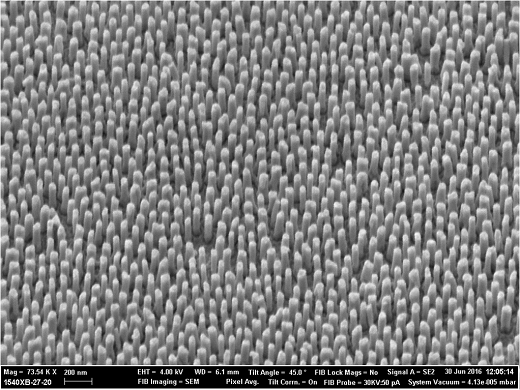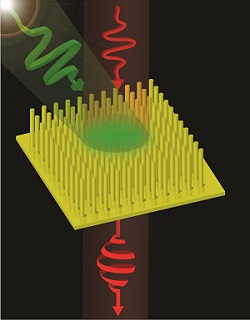Researchers at King’s College London have developed a series of nano-structured materials that rapidly change the polarisation of light faster than electronic methods currently allow. The materials, described in today's Nature Photonics, could lead to faster data transfer rates, better quantum computer construction and advanced research into new materials.

An scanning electon microscope image of the new nanostructures. (Credit: King's College London)
The new nano-structures, which are a type of metamaterial, comprise gold nano-particle features smaller than a thousandth of a millimetre that produce exotic optical effects. When the metamaterial absorbs a high intensity light pulse, energy is injected into the electrons of the gold particles, which causes the refractive index of the material to change. If a second pulse is then fired at the material at the same time, the altered refractive index causes its polarisation to switch instantaneously.
This process of controlling the polarisation of light using light itself is known as ‘all-optical polarisation control’, and having this happen so rapidly enables the researchers to change the polarisation of light trillions of times per second.
Switching polarisation can be used to transfer digital information at fast rates along fibre optic cables, as each state of polarisation can be used to represent a one or a zero. While electronic methods are currently used to achieve this switching, these are now reaching a physical limit for the speed they can offer, which restricts the amount of data that can be sent using them.
‘With everybody using more and more data, streaming videos, music and sharing pictures, we are fast approaching a point where the current internet infrastructure will not be able to cope,’ confirmed Luke Nicholls, the PhD student who carried out these experiments. ‘All-optical control provides an answer to this looming problem and hopefully sees an end to staring at the infuriating buffer wheel.’

The nanostructures use a technique known as ‘all-optical polarisation control’ to switch the polarisation of light trillons of time's per second. (Credit: King's College London)
The researchers’ metamaterial overcomes speed restrictions by enabling polarisation to be switched at timescales of less than a millionth of a millionth of a second - hundreds of times faster than electronic methods. This will help meet the growing data sharing demands of modern streaming and cloud services.
Control of light at such short time scales could also feed into quantum information processing, where controlling the polarisation of light is integral for building successful quantum computing devices.
The breakthrough will also enable scientists to ‘see’ very fast nano-scale processes, such as certain chemical reactions, for the first time by illuminating them with rapidly changing light. This will help them understand the difference between the formation of dangerous chemicals and life-saving drugs, according to the King’s researchers, while also potentially enabling the study of new materials that could feature heavily in future technology.
‘This effect opens up many opportunities for new applications which can directly impact everyday life,’ commented Professor Anatoly Zayats of King’s College. ‘The faster you can control light polarisation, the faster you can use light to transmit data and make measurements.’

